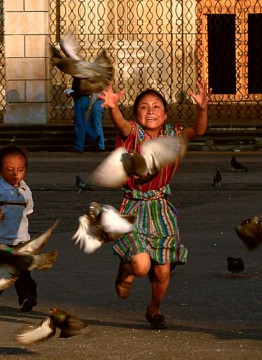On December 29, 1996, Peace Accords were signed in Guatemala, bringing to an end the thirty-five year civil war. The Accords opened the door to massive civilian reconstruction and long needed socio- economic reforms. Daunting obstacles remain.

A Mayan child chases doves in front of the Cathedral pillars where the names of Mayans massacred during the war are memorialized, Guatemala City, Guatemala.
The causes of the war itself–extreme poverty, racial discrimination, and a highly skewed distribution of national wealth and resources–remained unchanged. Socio-economic conditions in 1996 remained similar to those of South Africa under apartheid. Although the Mayan people compose some 80% of the national population, they are treated as a de facto minority. Stripped of their lands during the Spanish conquest and settlement, displaced by the years of conflict, many are landless migrants. They suffer high rates of illiteracy, malnutrition and an infant mortality second only to that of Haiti. Despite these conditions, the Mayans have maintained their twenty-two languages, their culture, and their religious beliefs, fiercely refusing to assimilate.
The civil war arose from these conditions. The response from the Guatemalan military was brutal. In the 1980s their counter-insurgency campaign left 200,000 mostly Mayan civilians victims of a campaign of torture and extermination by the army and officially sponsored death squads. Some 440 Mayan villages were destroyed; thousands of survivors were forced into exile. Although the Mayan population suffered the brunt of the repression, others who worked for reforms were silenced as well. Union members, academic spokespersons, religious leaders, political dissidents, and civil rights leaders were liquidated and their work destroyed.
It is because of the work of two major documentation projects that these facts have come to light. The first, Guatemala: Nunca Mas was initiated in 1995 by Guatemalan archbishop Juan Gerardi and published in 1998. Gerardi was murdered days later. The second Guatemala: Memory of Silence was initiated after the 1996 Peace Accords by a UN sponsored team and published in 1999. Forensic anthropolgists continue to work to identify massacre victims adding another layer of scientific evidence and restoring at least a dignified burial to the victims and their surviving family members.
Links:
- BBC: Report on the genocide.
- The Guatemalan Documentation Project at the George Washington University’s National Security Archive.
- Memoria del Silencio: official report of the UN Truth Commission on Guatemala, in spanish.
- Putting the Pieces Back Together: Essay on the reconciliation process.